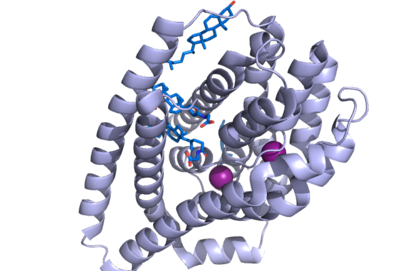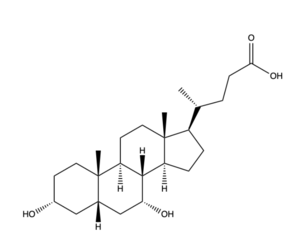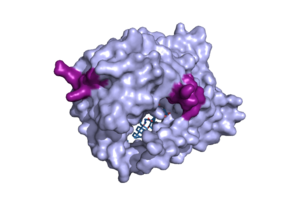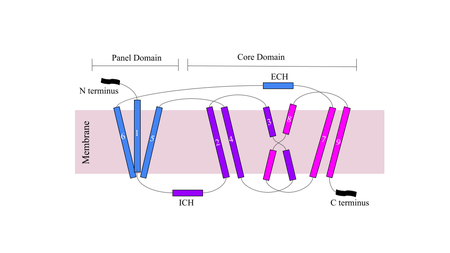Sandbox Reserved 1783
From Proteopedia
(Difference between revisions)
| Line 8: | Line 8: | ||
NTCP also acts as a receptor for Hepatitis B virus and Hepatitis D virus. The bile salts transported by NTCP are located within the gastrointestinal tract of the body and play a very key role in many biological functions. These functions include digesting and absorbing nutrients by helping break down fats and transporting lipid soluble nutrients into the liver. <Ref> Maldonado-Valderrama, J., Wilde, P., Macierzanka, A., & Mackie, A. (2011). The role of bile salts in digestion. Advances in colloid and interface science, 165(1), 36–46. [https://doi.org/10.1016/j.cis.2010.12.002 DOI: 10.1016/j.cis.2010.12.002]. </Ref>. The NTCP carrier protein itself can be found within hepatocytes, or the epithelial cells of the liver, but more specifically, within the basolateral membrane of these cells. <Ref name="Asami"> Asami J, Kimura KT, Fujita-Fujiharu Y, Ishida H, Zhang Z, Nomura Y, Liu K, Uemura T, Sato Y, Ono M, Yamamoto M, Noda T, Shigematsu H, Drew D, Iwata S, Shimizu T, Nomura N, Ohto U. Structure of the bile acid transporter and HBV receptor NTCP. Nature. 2022 Jun; 606 (7916):1021-1026. [https://dx.doi.org/10.1038/s41586-022-04845-4 DOI: 10.1038/s41586-022-04845-4]. </Ref>. The uptake of bile salts into the liver also allow for drugs to be both absorbed and excreted, as well as essential nutrients such as Vitamin A,D,E, and K to be absorbed in the small intestine. | NTCP also acts as a receptor for Hepatitis B virus and Hepatitis D virus. The bile salts transported by NTCP are located within the gastrointestinal tract of the body and play a very key role in many biological functions. These functions include digesting and absorbing nutrients by helping break down fats and transporting lipid soluble nutrients into the liver. <Ref> Maldonado-Valderrama, J., Wilde, P., Macierzanka, A., & Mackie, A. (2011). The role of bile salts in digestion. Advances in colloid and interface science, 165(1), 36–46. [https://doi.org/10.1016/j.cis.2010.12.002 DOI: 10.1016/j.cis.2010.12.002]. </Ref>. The NTCP carrier protein itself can be found within hepatocytes, or the epithelial cells of the liver, but more specifically, within the basolateral membrane of these cells. <Ref name="Asami"> Asami J, Kimura KT, Fujita-Fujiharu Y, Ishida H, Zhang Z, Nomura Y, Liu K, Uemura T, Sato Y, Ono M, Yamamoto M, Noda T, Shigematsu H, Drew D, Iwata S, Shimizu T, Nomura N, Ohto U. Structure of the bile acid transporter and HBV receptor NTCP. Nature. 2022 Jun; 606 (7916):1021-1026. [https://dx.doi.org/10.1038/s41586-022-04845-4 DOI: 10.1038/s41586-022-04845-4]. </Ref>. The uptake of bile salts into the liver also allow for drugs to be both absorbed and excreted, as well as essential nutrients such as Vitamin A,D,E, and K to be absorbed in the small intestine. | ||
| + | |||
| + | [[Image:Bile Salt structure.png|300 px|left|thumb|'''Figure 2.''' Bile Salt Structure.]] | ||
== Structural Overview == | == Structural Overview == | ||
| Line 37: | Line 39: | ||
== Significance == | == Significance == | ||
| - | + | NTCP is a key player in the absorption and digestion of fats and fat-soluble vitamins in the body, as well as the synthesis of bile within the liver. The uptake of bile salts, transcriptional and post-transcriptional, are signaling molecules for the liver and intestine. Bile salt, the transporting molecule of NTCP, aids in the absorption of lipophilic nutrients and vitamins in the small intestine. Additionally, bile salt plays a role in the endocrine system, excretion of toxins, and cholesterol maintenance. ADD GOUTAM REFERENCE HERE. Thus, the significance of NTCP lies with the importance of bile salts; NTCP is necessary in maintaining bile salt levels and thus necessary in maintaining the aforementioned biological processes. | |
=== Bile Salt Uptake === | === Bile Salt Uptake === | ||
| - | + | Cirrhosis, commonly known as the last stage of liver disease, is due to a deficiency in the bile acid supply in the liver. Bile acid pools, as defined by Vlahcevic, are the negatively-charged precursors to bile and often are conjugated to positively-charged bile salts. This is attributed either a decrease in the production of bile salts or a large increase in the excretion of this molecule out of the cell. https://www.gastrojournal.org/article/S0016-5085(71)80053-7/pdf Cirrhosis causes symptoms such as jaundice, abdominal pain and swelling, and swelling of the legs and feet. A patient who has type two diabetes, men, and those who have or do abuse alcohol are also more sustainable to developing Cirrhosis. This diagnosis can lead to liver failure and other life-threatening diseases, making bile salt uptake essential to liver function. https://www.niddk.nih.gov/health-information/liver-disease/cirrhosis/definition-facts | |
| - | + | ||
| - | + | ||
=== HBV/HDV === | === HBV/HDV === | ||
Revision as of 19:45, 10 April 2023
| This Sandbox is Reserved from February 27 through August 31, 2023 for use in the course CH462 Biochemistry II taught by R. Jeremy Johnson at the Butler University, Indianapolis, USA. This reservation includes Sandbox Reserved 1765 through Sandbox Reserved 1795. |
To get started:
More help: Help:Editing |
Sodium Taurocholate Co-Transporting Peptide
| |||||||||||
References
- ↑ Goutam, K., Ielasi, F.S., Pardon, E. et al. Structural basis of sodium-dependent bile salt uptake into the liver. Nature 606, 1015–1020 (2022). DOI: 10.1038/s41586-022-04723-z.
- ↑ Maldonado-Valderrama, J., Wilde, P., Macierzanka, A., & Mackie, A. (2011). The role of bile salts in digestion. Advances in colloid and interface science, 165(1), 36–46. DOI: 10.1016/j.cis.2010.12.002.
- ↑ 3.0 3.1 3.2 3.3 Asami J, Kimura KT, Fujita-Fujiharu Y, Ishida H, Zhang Z, Nomura Y, Liu K, Uemura T, Sato Y, Ono M, Yamamoto M, Noda T, Shigematsu H, Drew D, Iwata S, Shimizu T, Nomura N, Ohto U. Structure of the bile acid transporter and HBV receptor NTCP. Nature. 2022 Jun; 606 (7916):1021-1026. DOI: 10.1038/s41586-022-04845-4.
- ↑ 4.0 4.1 Xiangbing Qi, Wenhui Li. (2022). Unlocking the secrets to human NTCP structure. The Innovation, Vol. 3, Issue 5. 100294, ISSN 2666-6758, DOI: 10.1016/j.xinn.2022.100294.
- ↑ Liu, H., Irobalieva, R.N., Bang-Sørensen, R. et al. Structure of human NTCP reveals the basis of recognition and sodium-driven transport of bile salts into the liver. Cell Res 32, 773–776 (2022). DOI: 10.1038/s41422-022-00680-4.





